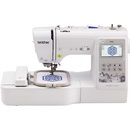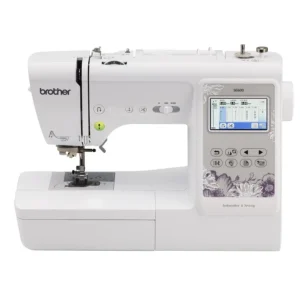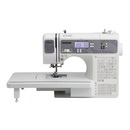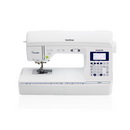I still remember the day the Brother SE600 arrived on my porch—the brown Amazon box felt like Christmas come early. I sliced the tape, lifted the Styrofoam, and there it was: a sleek white-and-silver powerhouse that practically whispered, “Let’s get stitching.” This is my personal Brother SE600 review, stitched together from months of wins, hiccups, and late-night “just one more design” sessions, plus a few nuggets I dug out of other Brother SE600 reviews along the way.
The honeymoon: love at first stitch
The very first thing I did—after snapping a photo, naturally—was thread the machine following the bright, numbered path printed right on the casing. Ten minutes later the needle threader clicked and I was monogramming a dish towel with the built-in block font. The touchscreen showed each color step like a tiny animated movie, and the motor purred so softly my cat kept napping on the table. I was hooked.
When reality set in
By week two the glow dimmed a bit. The 4 × 4-inch hoop felt roomy…until I tried a five-letter name in script. Real estate vanished fast, and splitting a bigger design with a repositionable hoop sent me to YouTube for help. Then I discovered the cheap-thread curse: bargain cones shredded, nested, and chewed needles for breakfast. Swapping to 40-wt polyester up top and pre-wound 60-wt bobbins fixed 90 % of my snarls. Lesson learned: quality thread is cheaper than ruined fabric.
My “a-ha” moments
- Read the manual cover-to-cover. It’s not beach fiction, but it tells you exactly how to switch from sewing to embroidery (yes, you really do need the Q foot and the straight stitch plate).
- Organ needles are magic. 75/11 for most designs, 90/14 when I tackle denim patches. Fewer breaks, quieter stitches.
- Dust is the enemy. A $15 mini-vac keeps lint out of the bobbin race. I oil the hook once a month—one drop, no more.
- Stabilizer matters. Tear-away for towels, cut-away for T-shirts, wash-away film on top of terry. Ignore this and you’ll meet “The Safety Device Has Been Activated” screen way too often.
- Free software first. Embrilliance Express lets me merge letters, Ink/Stitch converts SVGs to PES. I didn’t touch the pricey programs until I knew I loved the craft.
Everyday sewing surprises
I bought the SE600 mainly for embroidery, yet now I hem jeans and quilt binding with it more than my old mechanical Singer. The speed slider feels like cruise control, the automatic thread-cutter is addictive, and the buttonhole foot turns shirts into boutique-ready garments. My only gripe is the foot pedal cord; after three months it needed a gentle wiggle to wake up, so I mostly use the start/stop button instead.
Bumps in the road (and how I smoothed them)
- Touchscreen freeze on day one: a loose needle-plate cover was tripping the safety sensor. Snapped it down—problem solved.
- Missing embroidery foot out of the box: Amazon refunded me the cost of a replacement; keep your accessory list handy during unboxing.
- Thread nests at 5,000 stitches: usually a burr on the needle or the wrong spool cap. Flip the cap so it hugs the cone’s rim.
- Hoop strain on jackets: a magnetic Mighty Hoop turned bulky sleeves from nightmare to non-issue.
What I can—and can’t—do now
Monogram baby blankets, stitch felt patches, quilt free-motion swirls, draft my own PES logos, applique circle pockets, hem linen curtains, embroider a dozen towels for Grandma’s church bazaar… all on one machine that fits under a dust cover when I’m done.
What I can’t do? Anything larger than 4 × 4 in one pass. Sometimes I dream of the SE1900’s 5 × 7 field, but then I remember the SE600’s price tag and smile.
Final thoughts: will I keep rocking the Brother SE600?
Absolutely. It’s not perfect—no machine under $500 is—but it turned me from a cautious hobbyist into the family monogram queen without scaring my wallet. If you’re browsing Brother SE600 reviews wondering whether it’s beginner-friendly, versatile, and durable, take my stitched-up story as a loud “yes.” Treat it to good thread, a dust cover, and a little patience, and the Brother SE600 will reward you with projects that look like they walked out of a boutique—no matter how new you are to the craft.
Pros and Cons of the Brother SE600 based on Customers Reviews
| Pros | Cons |
|---|---|
| Beginner-friendly setup – touch screen walk-throughs, numbered thread path and built-in tutorials make first stitches/embroidery surprisingly quick for newcomers. | Small 4 × 4 in. hoop – many owners outgrow it fast; multi-position hoops help but require a new learning curve or precise re-hooping. |
| Versatile 2-in-1 machine – switches from regular sewing to embroidery in minutes, letting users monogram, hem, quilt and patch on one platform. | Software & design ecosystem costs – Brother’s desktop software and iBroidery downloads are pricey, and Mac support is limited; several reviewers turned to free or Etsy files. |
| Automatic conveniences – needle threader, thread-cutter, bobbin-drop, speed slider and start/stop button reduce hand strain and foot-pedal use. | Learning curve for advanced features – threading errors, tension hiccups and bobbin nests appear until users follow the manual or YouTube guides closely. |
| Quiet but powerful motor – sews smoothly through denim, canvas and quilt layers while staying neighbor-friendly. | Quality-control misses – scattered reports of missing embroidery feet, broken needle-plate hooks, defective touchscreens, or faulty power/foot-pedal ports. |
| Color LCD & USB port – preview color steps and import PES files from a flash drive; great for personal logos. | Need for premium consumables – cheap needles or thread cause breaks, nests and “safety device” errors; owners recommend Organ needles and 40 wt polyester. |
| Good stitch quality & variety – 100+ utility stitches, neat buttonholes, and five fonts satisfy most everyday sewing tasks. | Limited built-in embroidery catalog – many users wanted more than the stock motifs/fonts and were disappointed by sparse free downloads. |
| Gentle price point – often under $400, viewed as high value versus other entry-level combo machines. | Hoop & jacket bulk issues – thick items (caps, sleeves, puff coats) are tricky without aftermarket magnetic hoops. |
| Reliable “little workhorse” – long-term owners note thousands of stitches with only routine cleaning/oiling. | Needle threader durability – several reviewers say it bends or quits after a few months and requires dealer repair. |
| Strong online support community – abundant SE600 tutorials on YouTube, Facebook groups and forums fill gaps the manual misses. | Sparse official documentation – manual glosses over embroidery setup; users rely heavily on third-party videos. |
| Portable & space-saving – lighter than many sergers/quilt machines; easy to carry to classes or craft shows. | Embroidery speed & jump trimming – slow versus multi-needle models and doesn’t auto-clip same-color jumps, adding touch-up time. |





